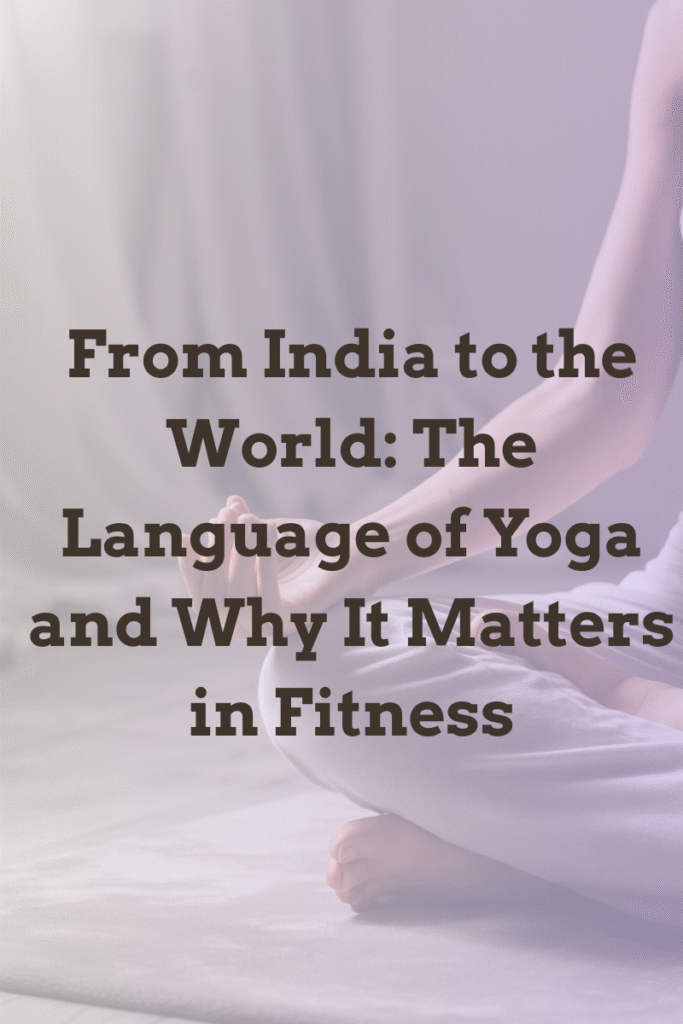Yoga is more than just stretching on a mat or striking a graceful pose for Instagram. It is one of the six classical schools of Hindu philosophy, and it has also been a major part of Buddhist meditation practices. At its core, yoga is both a science and an art; a spiritual discipline designed to bring harmony between mind and body.
But as yoga spread from India to the rest of the world, something fascinating happened: it started to “speak” in many different languages. Today, you can walk into a yoga studio in New York, Madrid, or Tokyo and hear instructions in English, Spanish, or Japanese. The poses are the same, but the words and the connection they create change everything.
The Roots of Yoga
The word “yoga” comes from the Sanskrit root “yuj,” meaning to join, to unite, or to yoke. Yogic scriptures describe it as the union of the individual consciousness with the universal consciousness; a state of perfect harmony between the mind and body, between humanity and nature.
Yoga as a practice originated nearly 5,000 years ago in Rishikesh, a city in northern India often called the “Yoga Capital of the World.” Originally, yoga was never meant to be just physical exercise. It was a lifestyle, a way to live mindfully, to breathe with awareness, and to align one’s body with deeper consciousness.
Yet, despite its deeply spiritual origins, yoga captured the imagination of people across the globe. And language was at the heart of that journey.
Why Sanskrit Still Matters
If you’ve ever taken a yoga class, you may have heard unfamiliar words like Adho Mukha Svanasana or Bhujangasana. That’s because the original language of yoga is Sanskrit. One of the oldest languages in the world and the root of many Indian languages.
Sanskrit gives yoga depth. The names of poses are more than just labels — they carry stories, philosophy, and symbolism. For example:
- Adho Mukha Svanasana → Downward Facing Dog
- Bhujangasana → Cobra Pose
- Pranayama → Breath Control
But as yoga traveled, these names were translated. In Spain, Downward Dog became Perro boca abajo. In Germany, Cobra Pose is taught as Kobra. And in English-speaking countries, Sanskrit often gave way to shorter, simpler translations.
Why Translation Matters in Yoga
At first, you might think: does it really matter what we call a pose, as long as we’re practicing it? The answer is yes — because yoga is nothing without clear, mindful instruction.
Imagine a teacher guiding you through a flow. If they use words you don’t understand, you lose the rhythm. Your breath breaks. Your body hesitates. The connection fades. That’s why translation in yoga is not just linguistic, it’s essential for safe, mindful practice.
When instructions come in your own language, you feel connected. You understand not just what to do, but how to do it. You’re more likely to breathe correctly, to hold the posture safely, and to experience yoga as it was meant to be.
Yoga Goes Global: The Language of Connection
In India, yoga begins with Sanskrit chants. In the U.S., most classes start with “take a deep breath.” In Spain, you’ll hear Respira profundamente. Different words, same purpose: to guide you into mindfulness.
This global spread of yoga shows how language creates belonging. If someone in Madrid is told to do Pranayama, they may struggle to feel the connection. But if you explain it in Spanish as ejercicios de respiración consciente, they immediately relate. They not only follow the movement but also feel ownership of it.
Language builds trust, and trust builds deeper practice. That’s why yoga’s global journey is also a linguistic journey.
Beyond Yoga: Pilates, Fitness Challenges, and Language
It’s not just yoga. Pilates too was not born in English. Created by Joseph Pilates in Germany, it originally used German terminology. Over time, Pilates also got translated into English and then into dozens of other languages.
The same applies to global fitness challenges. From Zumba to HIIT programs. Every fitness trend that crosses borders has to be translated so participants can connect with it. Imagine joining a 30-day fitness challenge where all instructions are in a language you don’t understand. You wouldn’t just feel lost; you’d feel excluded.
That’s why language matters in fitness as much as in yoga.
Why Language Is Key to Your Fitness Journey
Think about this: Have you ever followed a YouTube yoga class or a Pilates workout video in your own language and felt instantly more motivated? That’s because when fitness “speaks your language,” it doesn’t just instruct you, it connects with you emotionally.
Language is not just a medium of instruction; it’s a bridge of trust. A fitness trainer who speaks your language feels less like a seller and more like a well-wisher — someone who genuinely cares about your progress.
So, the next time you join a yoga or Pilates session, notice the words. The language shaping your breath, your movement, your focus . It matters more than you think.
In Summary
Yoga started in India, in Sanskrit, as a union of body, mind, and spirit. Today, it is a global practice, taught in every major language on Earth. Pilates too, and even modern fitness challenges, follow the same path.
The lesson is simple: language is the key that unlocks fitness for everyone. It makes practices safer, instructions clearer, and experiences more personal.
If you want your fitness journey or your fitness business, to truly connect with people, don’t just sell workouts. Speak their language. Share their emotions. Make them feel that the practice belongs to them.
Because whether it’s yoga, Pilates, or any workout challenge, fitness isn’t just about moving the body. It’s about moving the heart; and nothing moves the heart like hearing words in your own language.
